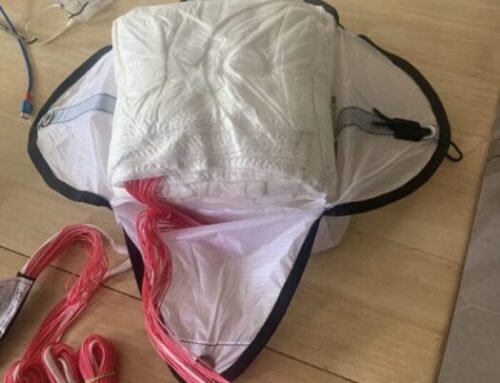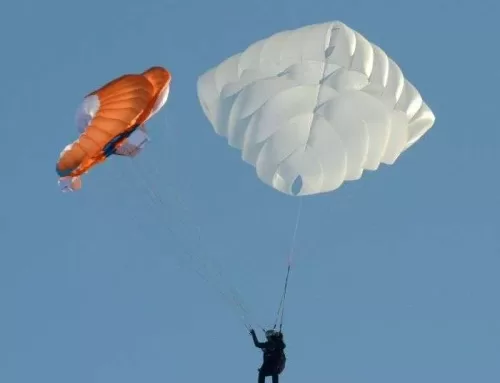Replace a Paragliding Helmet? 
It seems a bit odd to me, we often talk about how long our wings & reserves will last and how to properly care for our paragliding equipment, but we rarely talk about when its time to replace a paragliding helmet! Our helmet is the one piece of equipment that protects our head and is so often overlooked. The biggest factor is safety, I mean this is why you are wearing the helmet anyway right?
Why should we replace a helmet that looks ok, has no big cracks, dents or tears on it?
According to Uvex, helmets older than eight years and used for a maximum of 5 years must be replaced, regardless of how often or how intensively the helmet has been used.
In everyday life, helmets are often subjected to rough treatment and are exposed to many environmental influences. This can sometimes lead to the material becoming damaged and wearing out faster than usual.
Basically, the following applies:
Paragliding helmets must be replaced after an accident or hard impact! This also applies if there is no obvious damage to the helmet.
What most people don’t know:
Even the best helmet and its components can wear out faster than normal. Correct handling of the helmet and regular care are crucial. Our tips and tricks for helmet care can be found here.
Can the helmet chin strap tear?
Under certain conditions chin straps can tear. Possible causes of premature material wear include improper cleaning with agents containing solvents, and excessive UV exposure, especially in combination with cosmetics, for example, sun creams.
Do You Need To Replace Your Helmet If You Drop It?
You may have heard that if you drop your helmet you need to replace. Unless you drop it from an extreme height then you probably won’t have to replace a paragliding helmet. I’ve seen paragliding gear fall off a moving car, sending the helmet bouncing down the road… Yep, time to replace that helmet!
Of course, you should check your helmet for any possible damage if you do drop it, but chances are you won’t need to replace it. You would have to drop your helmet from a significant height in order to damage it to the point that you need a new one.
Paragliding helmets are very sturdy and robust. The majority of helmets made by today’s safety standards can withstand unintentional wear and tear, especially if you purchase one from a reputable manufacturer. However, this does not mean you should be throwing your helmet around.
Helmet Material
Before we go any further, let’s quickly discuss the material a helmet is made from. Taking a look at the materials manufacturers use will help to give you a better understanding of helmet durability.
What is Paragliding helmet made of?
The majority of helmets consist of an outer shell made from some type of durable plastic, fiberglass, or carbon. These compounds are some of the most robust materials found on this planet. They will last for years to come.
They are extremely durable and have proof of the utmost resiliency. A simple drop of your helmet onto the ground should not cause it to become damaged if it is made from one of these compounds.
The interior helmet typically consists of dense foam to help absorb impact. If you dropped your helmet with something heavy inside of it, you may need to check the foam for deformation. The foam does a great job of absorbing and dispersing impact so dropping your helmet should not drastically impact the integrity of your helmet to the point that you need a new one.
You will also find some type of moisture-wicking lining inside your helmet as well. This lining will help absorb sweat and other moisture to preserve the integrity of the helmet. Unless you are filling your helmet with water and then letting it free fall from your roof, you do not have to worry about getting a new helmet if you accidentally drop it.
Signs You Need a New Helmet
Helmet Age
How old is your helmet? Like I mentioned at the beginning of this article, if you have worn your helmet for over 5 years, then it might be time to replace it.
But why should you replace your helmet every 5 years? After 5 years of consistent wear and tear, your helmet will have more than likely weakened. I know it may look like it is in perfect condition, but you should consider its age and the impact it has on the components of the helmet.
If you wear your helmet consistently, it becomes exposed to weather, dirt, UV rays, and other elements that you may not think about having an effect on the integrity of your helmet. These elements ultimately weaken the resins and glues that hold it together.
Although there is no definitive research on this, the 5 year age expiration date is enforced by most manufacturers. There are other factors that can play into the lifespan of your helmet. So even though 5 years is the recommended age limit for a replacement, it could be a few years less or more.
The average Shoei helmet lifespan is around 5 years. You can use that as a reference point since they are one of the most reputable brands in the industry. Also, Snell safety standards enforce a 5-year policy. Therefore, manufacturers make sure to abide by this to prevent potential lawsuits.
Usage
If you wear your helmet every day, it becomes exposed to constant wear and tear. It may not be entirely apparent but consistent use weakens the integrity of your helmet over time.
You can compare it to riding your bike or driving your car every day. As the miles stack up, you need to either perform more maintenance or purchase a new one.
Have You Been In An Accident?
This should be completely obvious, but this fact needs to be mentioned. If you have experienced an accident, then it may be time for a new helmet. You need to thoroughly check your helmet. Impacts are absorbed by the foam liner, the foam isn’t designed to re-bound. It takes the hit; absorbs the impact and it’s done its job. Often the damage cannot be seen.
Wearing a broken helmet will not serve you any protection. I can’t stress this enough. Do not wear a helmet that has been in an accident. It is simply not worth your life to save a few dollars.
Helmet Becomes Loose
When you buy a new helmet, it fits very snug. If you turn or shake your head, it remains stuck to your head like glue.
It’s time to replace a paraglider helmet if it has loosened, try this test. Shake your head side-to-side. Does it remain stuck to your head, or does it slide around? If your helmet slides around while shaking your head, this means your padding has become compacted and may be time for a replacement. You can also check for indentations in the foam lining.
Your helmet should hug your head firmly. You do not want to be in an accident wearing a loose helmet. Traumatic brain injury has been linked to loose-fitting helmets so make sure yours fits tightly or get a new one.
Interior Starts Deteriorating
Usually, it is not the outside shell that deteriorates first. It is typically the lining and foam inside of the helmet. If the inside of your helmet starts to flake off into your hair or onto your shoulders, that is a good sign you need a helmet replacement.
Whether this happens after 3 years of use or 5, I would seriously consider replacing a paragliding helmet. Since the EPS liner is usually painted black, you can also check for tiny white cracks forming inside of your helmet.
If this happens that means the integrity of the helmet is weakening and will not be able to absorb impact effectively. Be mindful if you use hair product as that can assist in deteriorating the insides of your helmet.
Exterior Start Deteriorating
If the shell of your helmet becomes brittle, has cracks, or begins to fall apart then you need to replace your helmet. I’m hoping this is obvious but just want to make sure that wearing a helmet in this weakened condition is not safe.
The shell is the first point of contact during an accident. Therefore, this part should be very strong and durable. Any cracks in the shell will instantly expose your head to injury if you are in an accident.
Strap or Lock Failure
Have the straps stopped working properly on your helmet? For those of you who wear your helmets often you may notice that your strap locks have become corroded due to weather and dirt.
Your helmet chin strap is a critical component to keeping your helmet on your head. If this part does not work properly then it might be time to buy a new helmet or find a chin strap replacement.
Last thoughts on when to replace a paragliding helmet.
I’m sure you know that your brain is your number one priority when it comes to paragliding. Therefore, you need a helmet that works and when to replace a paragliding helmet is an important discussion to have with your fellow pilots.
Your helmet can last a while if your store it properly and perform regular maintenance. You should still consider the age and usage of your helmet when deciding to buy a new helmet.
Another reason to buy a new helmet, beyond the normal wear and tear, is the advances in helmet technology. It seems like every year manufacturers come out with new head protection designs that are better than previous versions.
Another key takeaway you should keep in mind is to never wear a used helmet. It may look fine on the surface but may have hidden cracks in the helmet that can go undetected by the human eye.



